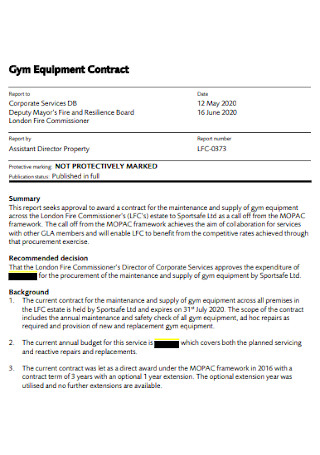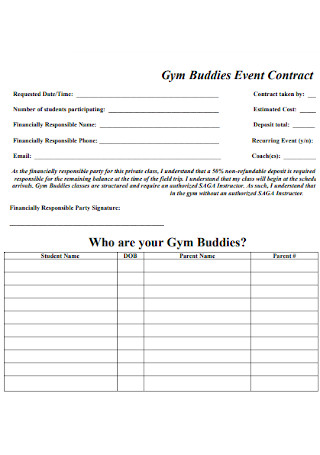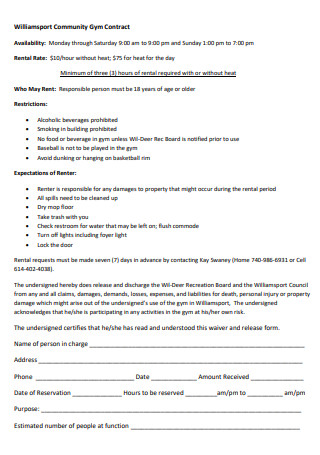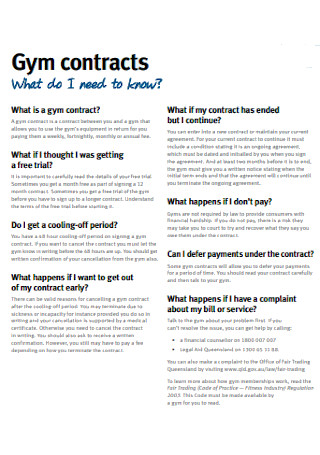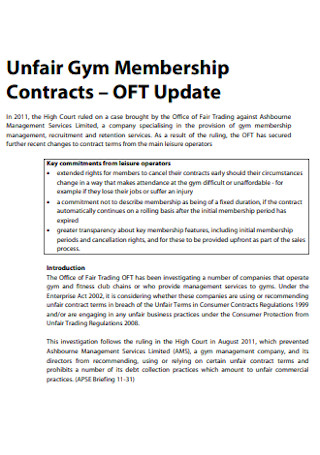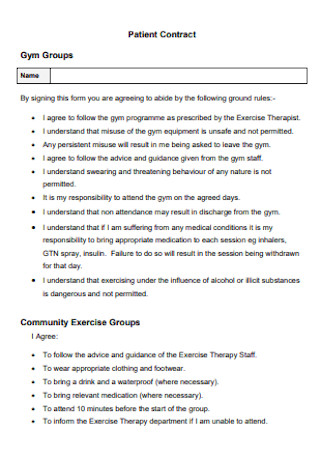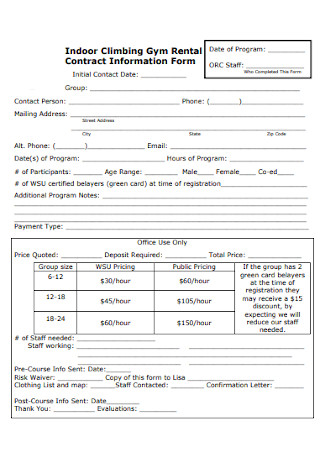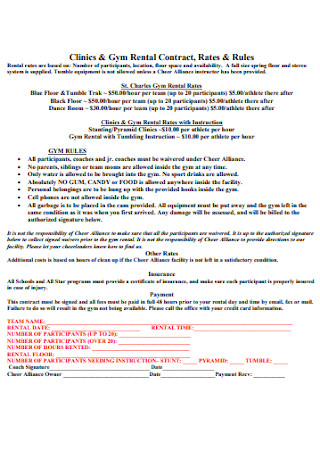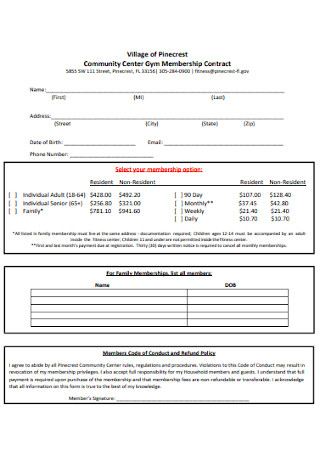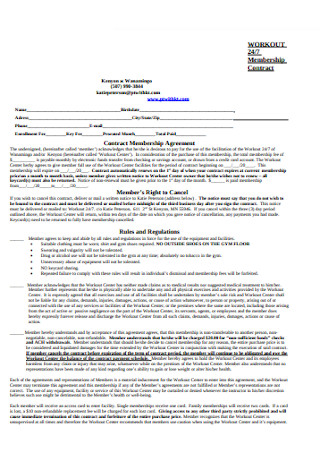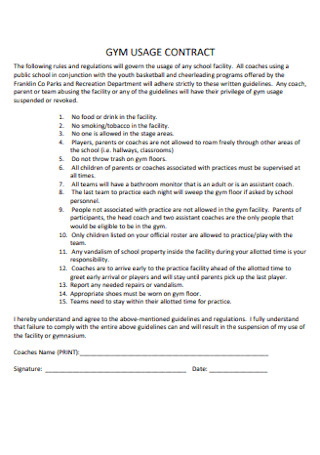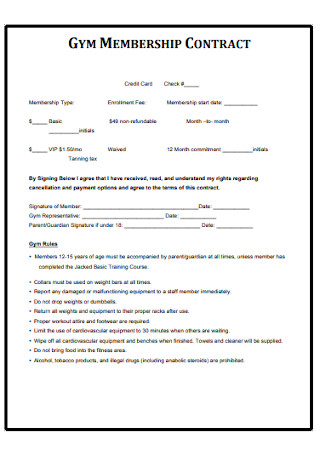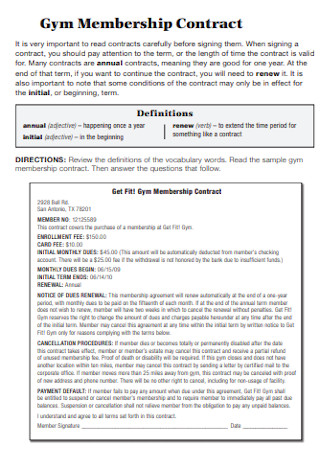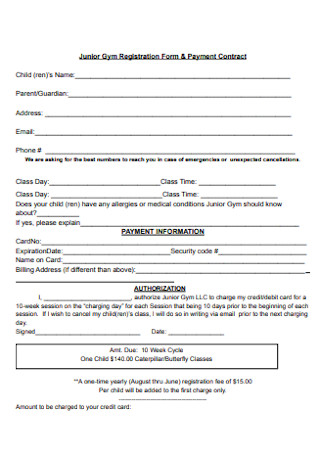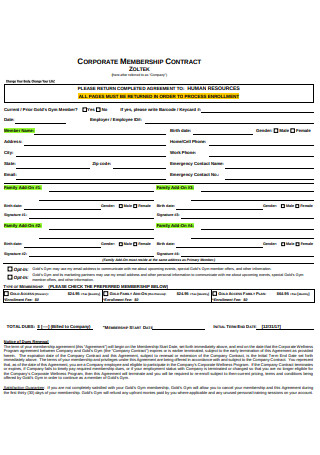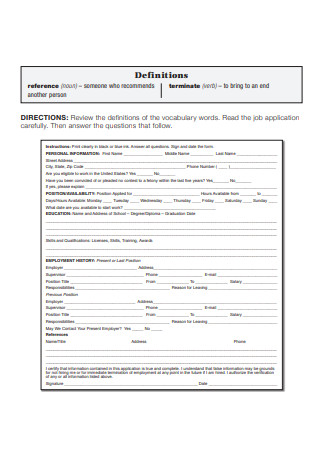FREE Gym Contract s to Download
What Is a Gym Contract?
A gym contract is a written agreement between a client and a gym company or management. It outlines the client’s membership, like what the member is entitled to as well exceptions and basic gym protocol.
According to NPR, experts are still wary about indoor sports and gatherings. Although gyms and other establishments are slowly reopening, the ongoing pandemic still poses a public health threat. Despite fitness studios and gyms upgrading and regularly disinfecting their facilities, experts still highly encourage minimum health protocols like mask-wearing and physical distancing.
Components of a Gym Contract
Gym contracts can be quite technical and can contain multiple details. That’s the reason why it’s important to read the fine print. The following are some basic elements outlined in a gym contract:
Basic Client Information: Applicants should always include their complete name and basic information including sex, birthday, email address, and contact number. Include the date of application too. Membership Options: Most gyms provide several options for membership. Options can be based on number of months, exclusivity of benefits, or frequency of use. For example, a regular gym membership can be valid anywhere from 3 months to 12 months. It can be subject to renewal or cancellation. A common promotional practice for gyms is offering discounts or flexible payment options to potential clients. Most standard forms have checkboxes with corresponding rates, where the applicant just needs to choose the type of membership. Gym Rules and Regulations: Most contracts detail house rules that are expected to be followed within gym premises. This ensures the clients are made aware of what practices are allowed and not allowed when in the gym. Some examples of house rules pertain to the use of communal facilities (e.g., locker rooms, showers), gym hours, food and drink policies, safety, and gym decorum. Personal Belongings: Gyms make it a point to remind clients and guests that management is not liable for any losses, and stolen or damaged property. This serves as a reminder that the client should always keep an eye on his personal property or possessions. If a client’s mobile phone was stolen while the gym-goer was in the shower, or a guest’s wallet was lost within the gym’s vicinity, the responsibility falls on the owner and cannot be imposed on the gym. Medical Clearance/Health Declaration: Gym management and administrators should always see to it that an applicant or potential client is in good physical condition before allowing them to use their facilities. A doctor’s note or medical clearance is often part of gym application requirements. An applicant needs to disclose if they have any physical conditions that may impede or pose a risk to their training and exercise. Duration of Membership: This can either be detailed separately in another section or indicated together with the membership types. Most gyms offer flexible payments schemes and it is dependent on the duration of the client’s membership. Typically, members pay monthly dues to keep using the facilities and services of the gym. Some gym memberships are good for 6 months and renewable after a time period. If the client prefers paying in full or quarterly, gyms usually accommodate the requests and make the necessary adjustments. Use of Facilities and Equipment: Gym contracts enumerate the available equipment and services a member is entitled to avail. It should clearly outline what is inclusive in the contract. Depending on the type of membership a client signed up for, he or she may be granted access to all facilities or limited to only certain equipment. The member may be allowed unlimited use of the treadmill and strength building equipment, but his contract may stipulate that aerobic or yoga classes entail a separate charge. Another stipulation may state exclusive use of all equipment and access to group classes, but may not include use of sauna and indoor pool. Special Cases: Many gym buffs and athletes see the value in hiring a personal trainer. A personalized program and customized training have several benefits. A gym contract may grant special requests and assign a trainer to a client, upon their request. Ground rules for personal training are basic but can also be varied. Some gyms prohibit tipping, house calls, or using two or more trainers. Usually, a client is assigned a trainer for the entire duration of membership. Payment Guidelines: Members typically pay monthly dues. The contract should specify the amounts and a breakdown of fees. Whether that’s enrollment fees, trainer fees, and other miscellaneous fees. Gyms are known to offer promotional rates to increase membership. Clients are given the freedom to choose a method of payment that is most convenient for them. For bank transactions, indicate the bank account details and specify the amount to be paid. The consequences for late or non-payment of dues is also specified in the contract. Late fees or termination of contract resulting from consistent non-payment for a period of time may likewise apply. Cancellation Policy: All gym contracts should contain a cancellation policy. If for any reason, a client decides to cancel his or her membership halfway through or only after two sessions, the gym should anticipate these scenarios and put into writing the consequences if that should happen. Much like a resignation letter, a client may be required to give a prior notice of contract termination. If applicable, he or she may also need to surrender a membership card or a reserved parking lot. In effect, a member who cancels the contract agrees to give up any of the privileges and benefits that he or she had as a member. Refund Guidelines: In relation to the cancellation policy, management should clearly outline the gym’s rules for refund. In an effort to encourage clients, gyms may also offer a free trial period. An applicant on trial basis can agree to pay for only a period of a few months. After which, the contract can either be renewed or not. The gym contract must stipulate the conditions where a partial or full refund is applicable. Release of Liability: Most gyms have clients sign a waiver when using gym equipment. The release of liability can either be integrated in the contract or given separately. This insures the gym that any exercise-related accident or untoward incident releases them of any liability. The client, as the releasor, is effectively responsible for his or her own safety when using gym facilities. Right to Modification and Termination of Contract: As the drafting party, the gym company or management has the right to terminate the contract based on prior agreed conditions. If a client displays unacceptable and unruly behavior, violates federal laws, or commits any major offense, the gym reserves the right to expel any member that breaches the contract agreement. This can be done without prior notice. Acceptance and Commitment: A basic gym contract normally includes a declaration statement at the end of the contract. It signifies that the client willingly accepts the above terms and remains committed to executing and honoring the contract. Signature: Like all contracts, a signature line is required. It should contain the printed name of the applicant and the date. The gym is not typically required to sign as it is understood that the gym is the sole drafting party.
Tips to Honor Your Gym Contract
In other words, how do you keep your gym promise? It’s not only a matter of promising the gym or your trainer that you will faithfully execute what is expected of you. It is also a promise to yourself- the promise of taking your health seriously and staying committed to fitness. In addition, you wouldn’t want to simply see your gym contract go to waste, because you also want to be able to get your money’s worth. The following tips can help you stay motivated in keeping your promise:
Introduce Variety: Many gyms offer a wide range of exercises and options to get fit. Some people love routine and prefer to stick to what works for them. Other people can get bored easily doing the same thing all the time. When it comes to working out, introduce some variety if it helps keep you interested and engaged. If you hit the gym several times a week, you can try different exercises each time. Try a dance or TRX class, combine circuit training with stretching and breathing techniques. You can mix it up with different cardio workouts like jogging, jump rope, etc. Variety will help you look forward to gym sessions. Have a Rest Day: You need to be able to give yourself time to recover and gain back your strength. Maxing out one’s energy will do more harm than good. Fitness is a balancing act. Your body needs time to recuperate from strenuous activity. Plus, having a couple of rest days will make you look forward to hitting it back again in the gym. Bring Friends or Make Friends: Working out is more enjoyable and fun when you have support with you. Invite a close friend to work out with you. And don’t be afraid to socialize with other gym-goers. Group exercises and classes are good ways to bond and mingle with other members. Sweating it out does not mean it can’t be fun and interactive. Pair Your Workout Routine With Proper Diet: The problem with most people is their preconception about fitness and health. You need to be able to manage your expectations and silence the urge for immediate gratification. It pays to be realistic in one’s goals. Many people give up because they don’t see any results. Health and wellness not only involves working out and going to the gym regularly, but it’s a combination of exercise, lifestyle, and a balanced diet. Your fitness goals should be a holistic approach and eventually, this will lead to better results. Get Tips From Your Trainer: If you have a personal trainer, don’t be afraid to ask for help. If you have trouble using certain gym equipment, approach a staff or ask your trainer for tips. It is good to establish connections in the gym because it enriches your experience. Working out in isolation is no fun. Take advantage of the interaction you have with your trainer. They often give useful insight on health and exercise routines. They can show you proper form when working out. Essentially, personal trainers are equipped with the right knowledge and skills; it’s up to you to be open to learning from them.
How to Write a Gym Contract
With the different elements of a gym contract laid out above, you can choose the ones that apply, and leave out the rest that do not. Follow this step-by-step guide in crafting your gym contract:
Step 1: Prepare the Format
Formats can vary but gyms typically prepare standard forms for clients to answer. These are standard forms that are easily available and reproducible, and are meant to accommodate walk-in customers, and online applications. It comes in a questionnaire form and all the important items are prepared for clients to conveniently fill out. Member terms and agreement are indicted after the basic client information. You also have the option to enumerate the types of membership. Explain these in brief detail and provide checkboxes beside each one. In some cases, management can also indicate the parties using a formal contract format. When stating the name of each party, make sure to include the complete name, date, age, and address.
Step 2: Indicate the Basic Details
A contract is meant to offer a comprehensive overview of the gym and its standard operations. It should always include essential details that the client must be informed of. These include, but are not limited to, the gym’s operating hours, equipment use, membership options, available group classes, personal trainer information, and other basic gym information.
Step 3: Outline the Terms and Conditions
Make sure the terms and conditions stipulated in your gym contract are clear and organized into sections. These sections include member obligations, payment information, safety and liability, health representations, cancellation and refund policy, indemnification and assumption of risk, etc.
Step 4: Commitment and Signature
To end your gym contract, provide a commitment agreement or declaration stating that the member enters into the contract voluntarily and agrees to the terms set by the gym. Make sure there is adequate space for the client to sign his or her name and the date.
FAQs
Can you get out of a gym contract?
You can get out of a gym contract. There may be monetary consequences in some cases. But gym contracts usually contain a cancellation policy. If you want to cancel your contract, it’s always best to inform the gym as soon as possible to avoid any inconveniences or unnecessary fees.
How long does a gym contract last?
The duration of a contract will depend on the type of membership a client has chosen. Gyms offer flexibility when it comes to length of membership. There are short and long-term options. Some offer a 1 month trial period. Others offer memberships good for 6 months, or up to 12 months.
Why do gyms have contracts?
Gyms need contracts with their clients for safety reasons, information dissemination, liability concerns, etc. It’s made to establish a mutual agreement to prevent any misunderstandings or unnecessary confusion.
Gym contracts are designed to extract accountability from both the gym and client. Signing a contract is easy; actually sticking to it may be a different story. Regardless, a contract is a binding document and both the member and the gym have certain expectations to live up to. Get started on your own gym contract by downloading a sample now!
